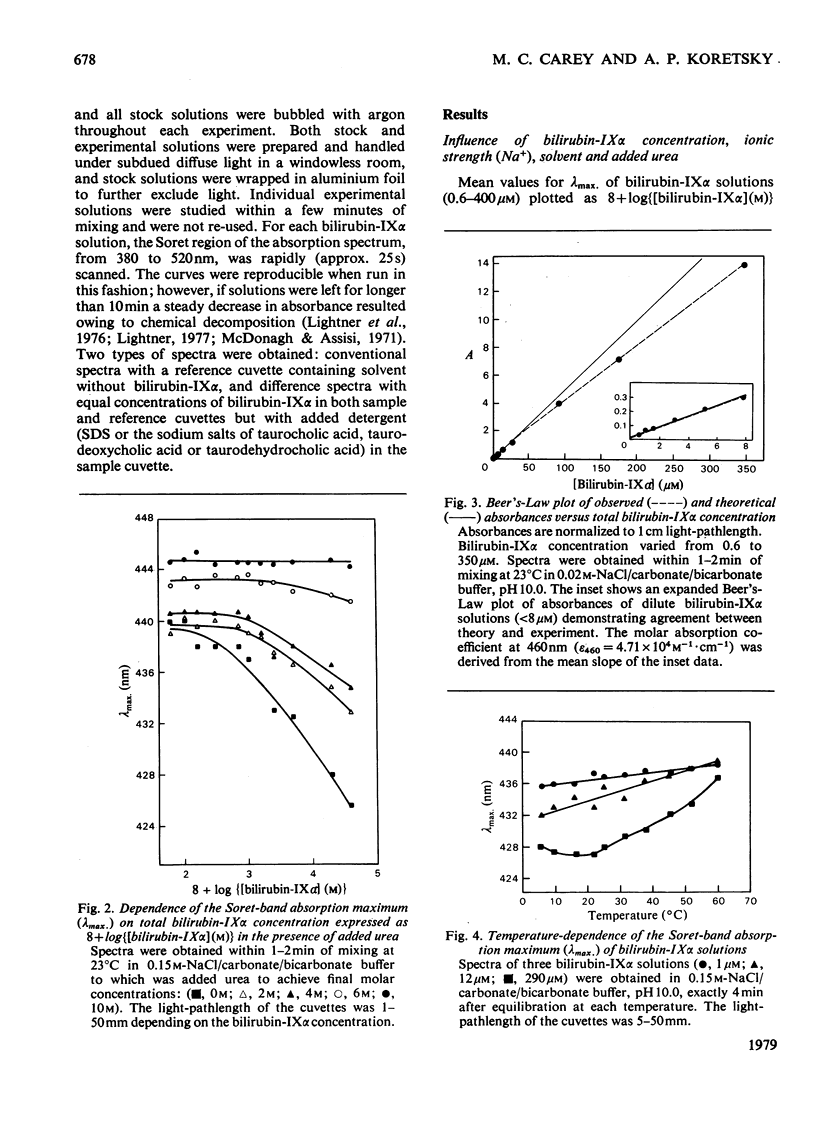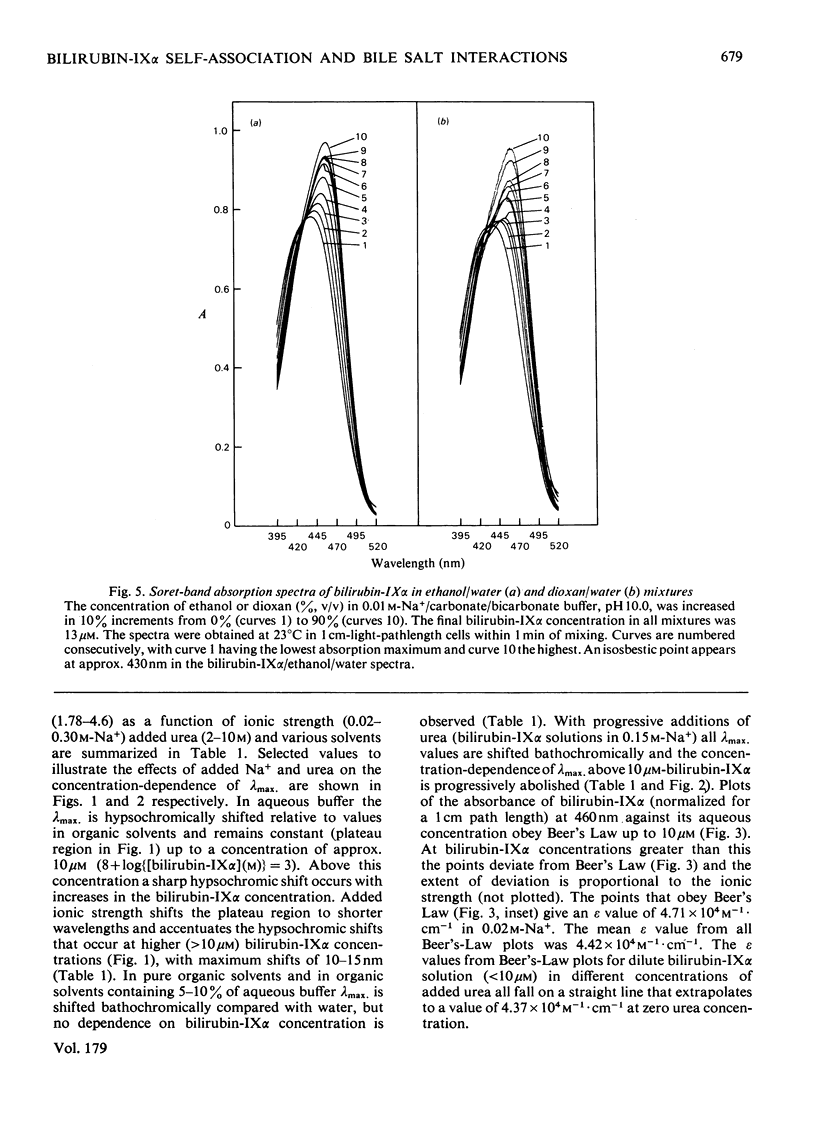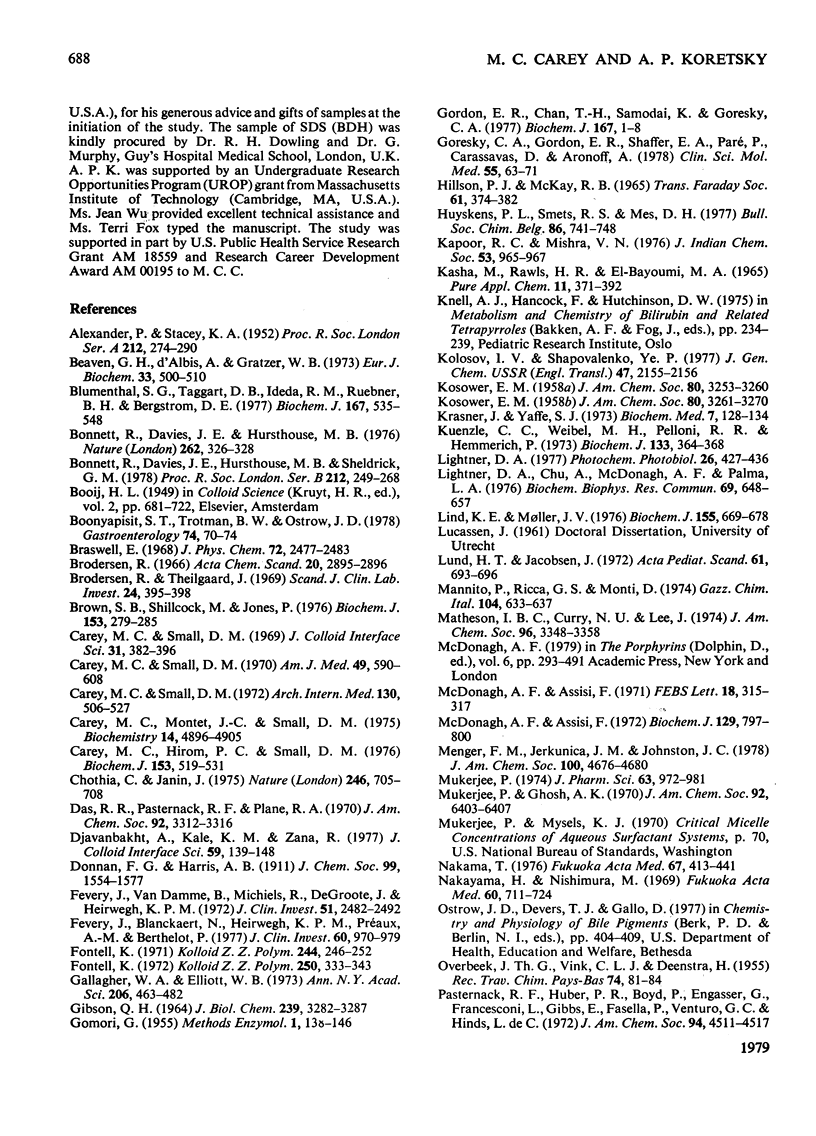Abstract
Spectrophotometric measurements of bilirubin-IX alpha in water and in aqueous/organic solvent mixtures at pH 10.0 as a function of bilirubin-IX alpha concentration (approx. 0.6--400 microM) are consistent with the formation of dimers (KD - 1.5 microM) in dilute (less than 10 microM) aqueous solution and further self-aggregation to multimers at higher concentrations. Added urea (to 10M) and increases in temperature (to 62 degrees C) obliterate the dimer-multimer transition at 10 microM, but added NaCl (to 0.30 M) promotes strong aggregation of dimers over a narrow concentration range, suggesting a 'micellization' phenomenon. Concentrations of dioxan or ethanol greater than 60% (v/v) in water were required to obtain the absorption spectrum of bilirubin-IX alpha monomers, suggesting that both hydrophobic and electrostatic (pi-orbital) interactions are involved in stabilizing the dimeric state in water. Micellar concentrations of sodium dodecyl sulphate induced spectrophotometric shifts in the dimer absorption spectrum of bilirubin-IX alpha consistent with progressive partitioning of bilirubin-IX alpha monomers into a relatively non-polar region of the micelles and allowed a deduction of the apparent critical micellar concentration that closely approximated the literature values. The pattern of bilirubin IX alpha association with bile salts is complex, since the absorption spectrum shifts hypsochromically below and bathochromically above the critical micellar concentration of the bile salts. Consistent with these observations, bilirubin IX alpha appears to bind to the polar face of bile salt monomers and to the polar perimeter of small bile salt micelles. At higher bile salt concentrations some-bilirubin-IX alpha monomers partition into the hydrophobic interior of the bile salt micelles. Our results suggest that under physiological conditions the natural conjugates of bilirubin-IX alpha may exhibit similar physical chemical properties in bile, in that dimers, highly aggregated multimers and bile salt-associated monomers may co-exist.
Full text
PDF














Selected References
These references are in PubMed. This may not be the complete list of references from this article.
- Blumenthal S. G., Taggart D. B., Ikeda R., Ruebner B., Bergstrom D. E. Conjugated and unconjugated bilirubins in bile of humans and rhesus monkeys. Structure of adult human and rhesus-monkey bilirubins compared with dog bilirubins. Biochem J. 1977 Dec 1;167(3):535–548. doi: 10.1042/bj1670535. [DOI] [PMC free article] [PubMed] [Google Scholar]
- Bonnett R., Davies J. E., Hursthouse M. B., Sheldrick G. M. The structure of bilirubin. Proc R Soc Lond B Biol Sci. 1978 Jun 23;202(1147):249–268. doi: 10.1098/rspb.1978.0066. [DOI] [PubMed] [Google Scholar]
- Bonnett R., Davies J. E., Hursthouse M. B. Structure of bilirubin. Nature. 1976 Jul 22;262(5566):327–328. doi: 10.1038/262326a0. [DOI] [PubMed] [Google Scholar]
- Boonyapisit S. T., Trotman B. W., Ostrow J. D. Unconjugated bilirubin, and the hydrolysis of conjugated bilirubin, in gallbladder bile of patients with cholelithiasis. Gastroenterology. 1978 Jan;74(1):70–74. [PubMed] [Google Scholar]
- Breaven G. H., D'Albis A., Gratzer W. B. The interaction of bilirubin with human serum albumin. Eur J Biochem. 1973 Mar 15;33(3):500–509. doi: 10.1111/j.1432-1033.1973.tb02709.x. [DOI] [PubMed] [Google Scholar]
- Brodersen R., Theilgaard J. Bilirubin colloid formation in neutral aqueous solution. Scand J Clin Lab Invest. 1969 Dec;24(4):395–398. doi: 10.3109/00365516909080178. [DOI] [PubMed] [Google Scholar]
- Brown S. B., Shillcock M., Jones P. Equilibrium and kinetic studies of the aggregation of porphyrins in aqueous solution. Biochem J. 1976 Feb 1;153(2):279–285. doi: 10.1042/bj1530279. [DOI] [PMC free article] [PubMed] [Google Scholar]
- Carey M. C., Hirom P. C., Small D. M. A study of the physicochemical interactions between biliary lipids and chlorpromazine hydrochloride. Bile-salt precipitation as a mechanism of phenothiazine-induced bile secretory failure. Biochem J. 1976 Mar 1;153(3):519–531. doi: 10.1042/bj1530519. [DOI] [PMC free article] [PubMed] [Google Scholar]
- Carey M. C., Montet J. C., Small D. M. Surface and solution properties of steroid antibiotics: 3-acetoxylfusidic acid, cephalosporin P1 and helvolic acid. Biochemistry. 1975 Nov 4;14(22):4896–4905. doi: 10.1021/bi00693a018. [DOI] [PubMed] [Google Scholar]
- Carey M. C., Small D. M. Micellar properties of dihydroxy and trihydroxy bile salts: effects of counterion and temperature. J Colloid Interface Sci. 1969 Nov;31(3):382–396. doi: 10.1016/0021-9797(69)90181-7. [DOI] [PubMed] [Google Scholar]
- Carey M. C., Small D. M. Micelle formation by bile salts. Physical-chemical and thermodynamic considerations. Arch Intern Med. 1972 Oct;130(4):506–527. [PubMed] [Google Scholar]
- Carey M. C., Small D. M. The characteristics of mixed micellar solutions with particular reference to bile. Am J Med. 1970 Nov;49:590–608. doi: 10.1016/s0002-9343(70)80127-9. [DOI] [PubMed] [Google Scholar]
- Chothia C., Janin J. Principles of protein-protein recognition. Nature. 1975 Aug 28;256(5520):705–708. doi: 10.1038/256705a0. [DOI] [PubMed] [Google Scholar]
- Das R. R., Pasternack R. F., Plane R. A. Fast reaction kinetics of porphyrin dimerization in aqueous solution. J Am Chem Soc. 1970 Jun 3;92(11):3312–3316. doi: 10.1021/ja00714a013. [DOI] [PubMed] [Google Scholar]
- Fevery J., Blanckaert N., Heirwegh K. P., Préaux A. M., Berthelot P. Unconjugated bilirubin and an increased proportion of bilirubin monoconjugates in the bile of patients with Gilbert's syndrome and Crigler-Najjar disease. J Clin Invest. 1977 Nov;60(5):970–979. doi: 10.1172/JCI108877. [DOI] [PMC free article] [PubMed] [Google Scholar]
- Fevery J., Van Damme B., Michiels R., De Groote J., Heirwegh K. P. Bilirubin conjugates in bile of man and rat in the normal state and in liver disease. J Clin Invest. 1972 Sep;51(9):2482–2492. doi: 10.1172/JCI107062. [DOI] [PMC free article] [PubMed] [Google Scholar]
- GIBSON Q. H. THE COMBINATION OF PORPHYRINS WITH NATIVE HUMAN GLOBIN. J Biol Chem. 1964 Oct;239:3282–3287. [PubMed] [Google Scholar]
- Gallagher W. A., Elliott W. B. Ligand-binding in porphyrin systems. Ann N Y Acad Sci. 1973;206:463–482. doi: 10.1111/j.1749-6632.1973.tb43230.x. [DOI] [PubMed] [Google Scholar]
- Gordon E. R., Chan T. H., Samodai K., Goresky C. A. The isolation and further characterization of the bilirubin tetrapyrroles in bile-containing human duodenal juice and dog gall-bladder bile. Biochem J. 1977 Oct 1;167(1):1–8. doi: 10.1042/bj1670001. [DOI] [PMC free article] [PubMed] [Google Scholar]
- Goresky C. A., Gordon E. R., Shaffer E. A., Paré P., Carassavas D., Aronoff A. Definition of a conjugation of dysfunction in Gilbert's syndrome: studies of the handling of bilirubin loads and of the pattern of bilirubin conjugates secreted in bile. Clin Sci Mol Med. 1978 Jul;55(1):63–71. doi: 10.1042/cs0550063. [DOI] [PubMed] [Google Scholar]
- Krasner J., Yaffe S. J. The automatic titration of bilirubin. Biochem Med. 1973 Feb;7(1):128–134. doi: 10.1016/0006-2944(73)90108-7. [DOI] [PubMed] [Google Scholar]
- Kuenzle C. C., Weibel M. H., Pelloni R. R., Hemmerich P. Structure and conformation of bilirubin. Opposing views that invoke tautomeric equilibria, hydrogen bonding and a betaine may be reconciled by a single resonance hybrid. Biochem J. 1973 Jun;133(2):364–368. doi: 10.1042/bj1330364. [DOI] [PMC free article] [PubMed] [Google Scholar]
- Lightner D. A., Cu A. On the autoxidation of bilirubin. Biochem Biophys Res Commun. 1976 Apr 5;69(3):648–657. doi: 10.1016/0006-291x(76)90925-6. [DOI] [PubMed] [Google Scholar]
- Lind K. E., Moller J. V. Ligand-apomyoglobin interactions. Configurational adaptability of the haem-binding site. Biochem J. 1976 Jun 1;155(3):669–678. doi: 10.1042/bj1550669. [DOI] [PMC free article] [PubMed] [Google Scholar]
- Lund H. T., Jacobsen J. Influence of phototherapy on unconjugated bilirubin in duodenal bile of newborn infants with hyperbilirubinemia. Acta Paediatr Scand. 1972 Nov;61(6):693–696. doi: 10.1111/j.1651-2227.1972.tb15968.x. [DOI] [PubMed] [Google Scholar]
- Matheson I. B., Curry N. U., Lee J. Reaction rate of bilirubin with singlet oxygen (1delta g) and its strong enhancement by added base. J Am Chem Soc. 1974 May 29;96(11):3348–3351. doi: 10.1021/ja00818a002. [DOI] [PubMed] [Google Scholar]
- McDonagh A. F., Assisi F. Commercial bilirubin: A trinity of isomers. FEBS Lett. 1971 Nov 1;18(2):315–317. doi: 10.1016/0014-5793(71)80475-1. [DOI] [PubMed] [Google Scholar]
- McDonagh A. F., Assisi F. The ready isomerization of bilirubin IX- in aqueous solution. Biochem J. 1972 Sep;129(3):797–800. doi: 10.1042/bj1290797. [DOI] [PMC free article] [PubMed] [Google Scholar]
- Mukerjee P. Micellar properties of drugs: micellar and nonmicellar patterns of self-association of hydrophobic solutes of different molecular structures--monomer fraction, availability, and misuses of micellar hypothesis. J Pharm Sci. 1974 Jun;63(6):972–981. doi: 10.1002/jps.2600630647. [DOI] [PubMed] [Google Scholar]
- Nakama T. [Significance of biliary cholesterol and bilirubin in gallstone formation (author's transl)]. Fukuoka Igaku Zasshi. 1976 Nov 25;67(11):413–441. [PubMed] [Google Scholar]
- Pasternack R. F., Huber P. R., Boyd P., Engasser G., Francesconi L., Gibbs E., Fasella P., Venturo G. C., Hinds L. de C. On the aggregation of meso-substituted water-soluble porphyrins. J Am Chem Soc. 1972 Jun 28;94(13):4511–4517. doi: 10.1021/ja00768a016. [DOI] [PubMed] [Google Scholar]
- Pope J. L. Crystallization of sodium taurocholate. J Lipid Res. 1967 Mar;8(2):146–147. [PubMed] [Google Scholar]
- Tipping E., Ketterer B., Christodoulides L., Enderby G. Spectroscopic studies of the binding of bilirubin by ligandin and aminoazo-dye-binding protein A. Biochem J. 1976 Jul 1;157(1):211–216. doi: 10.1042/bj1570211. [DOI] [PMC free article] [PubMed] [Google Scholar]
- Tipping E., Ketterer B., Koskelo P. The binding of porphyrins by ligandin. Biochem J. 1978 Mar 1;169(3):509–516. doi: 10.1042/bj1690509. [DOI] [PMC free article] [PubMed] [Google Scholar]
- Toyoda M. Quantitative determination of calcium bilirubinate in gallstone by infrared spectroscopy. Tohoku J Exp Med. 1966 Dec;90(4):303–316. doi: 10.1620/tjem.90.303. [DOI] [PubMed] [Google Scholar]
- Trotman B. W., Morris T. A., 3rd, Sanchez H. M., Soloway R. D., Ostrow J. D. Pigment versus cholesterol cholelithiasis: identification and quantification by infrared spectroscopy. Gastroenterology. 1977 Mar;72(3):495–498. [PubMed] [Google Scholar]


